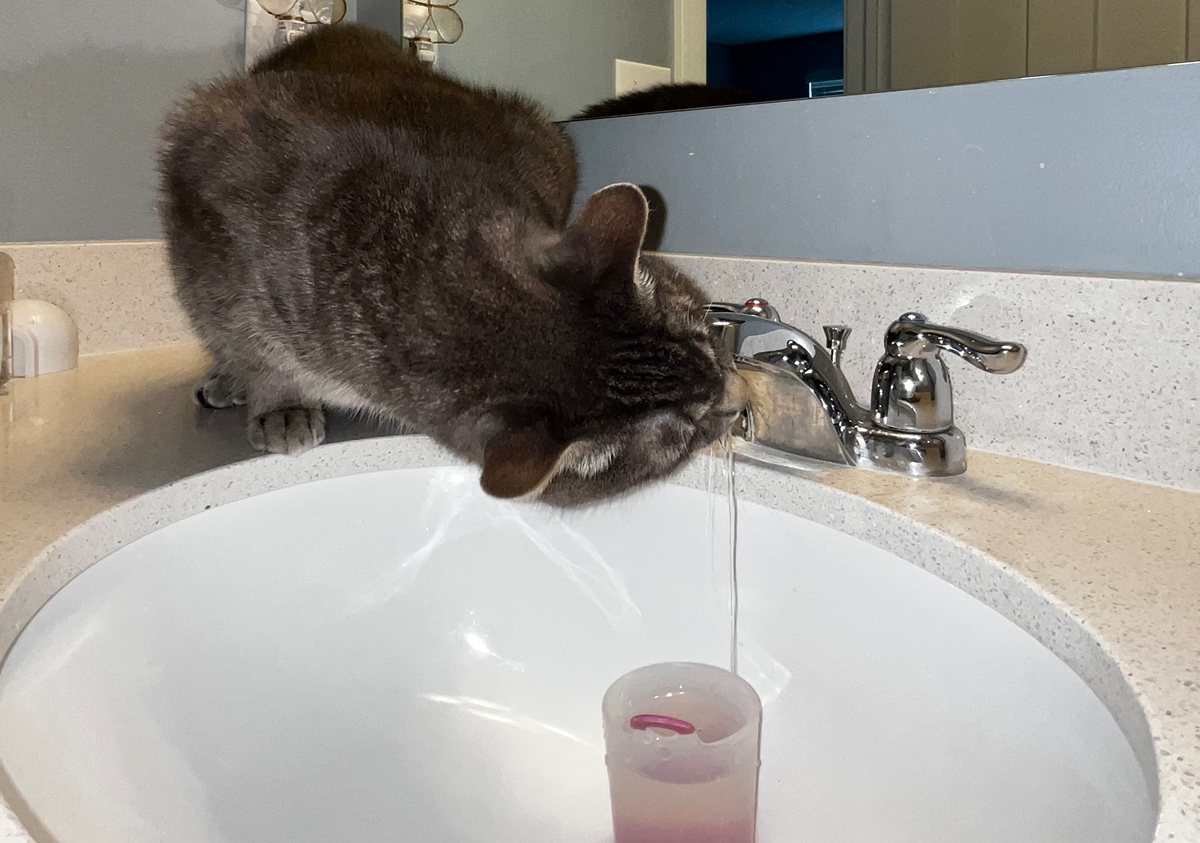Keeping your pets safe during the dog days of summer
As temperatures and humidity rise across the U.S., Candace Croney, director of the Center for Animal Welfare Science and professor of animal behavior and well-being, says it's important to remember that our furry friends need special attention to keep them safe.
 "When you begin to see warning notices about heat, humidity and air quality, it's important to take special notice for your pets and take steps to ensure their safety," said Croney. Heatstroke, a serious and even potentially life-threatening condition, occurs when your pet’s body temperature rises above the normal range of 100 to 102.5 degrees.
"When you begin to see warning notices about heat, humidity and air quality, it's important to take special notice for your pets and take steps to ensure their safety," said Croney. Heatstroke, a serious and even potentially life-threatening condition, occurs when your pet’s body temperature rises above the normal range of 100 to 102.5 degrees.
To keep your pets cool and healthy this summer, Croney shares the warning signs of overheating, and what to do if your pet is experiencing heat stress symptoms so that you can prevent more serious problems like heat stroke.
Prevention is key
Croney believes that pet owners can prevent many heat-related concerns by keeping in mind that if it is uncomfortably hot for you, it is even warmer for your pet, which requires being pro-active about how to protect them.
"If you are debating the wisdom of engaging in an activity outdoors yourself or taking special precautions for the heat, remember that the risks may be even higher for your pets, especially those with thick or dark-colored fur. Think of, for instance, going on a run in very warm temperatures, especially on a sunny or humid day and taking your dog along; consider what it would feel like if you were doing that run in a fur coat," Croney said.
It is also essential to consider the age, general health and condition of your animal(s) as this will affect how they respond to heat. "For instance, pregnant animals may need to be kept cooler than puppies or kittens. Older animals and those that are overweight or flat-faced, such as pugs, French bulldogs and some cats, may struggle more to regulate their body temperatures, especially under hot conditions. Knowing your animals and their specific needs and health concerns is important as a baseline for gauging how they may respond to the warmer temperatures," Croney said.
There are steps you can take to reduce the risk of overheating and heatstroke for your pet this summer season. Here are Croney’s tips for keeping heatstroke at bay.
Provide several water choices: Ensure access to fresh, potable water in copious amounts whether your pets are indoors or out. Croney notes it is essential to place the water where it will stay cool. "If you have a pet in the backyard and that area is not shaded, and especially if the dish is made of metal, the water will warm up. Pets will not want to drink hot water." Monitor how much your pets are drinking and how much they are urinating.
Keep them cool outdoors: Croney reminds pet owners that on these hot days, it is best to bring your pet(s) indoors during the hottest part of the day, typically 12 p.m. to 6 p.m. If they must be outdoors in hot and humid temperatures, provide areas in the shade for them to cool off. Remember that the levels of shade in different locations will change during the day, so avoid tying them outdoors or restricting their movement in ways that prevent them from seeking shaded, cooler area as necessary. Consider a sprinkler for them to run through or a kiddie pool where they may cool off if they choose.
While dog houses can provide shade, be mindful of the material they are made of. "Plastic dog houses can be very dangerous in the summer as they can get hot quickly. I would not suggest relying on your pets using these in extreme heat," Croney said. She also says simple measures like wetting a bandana that has also been cooled in a refrigerator and tying it around your pet's neck can help keep their body temperature down for brief periods on particularly hot days.
Consider a summer "haircut": Depending on the type of dog, shaving them might not be a bad idea to provide relief in the summer months.
Provide choices: It's vital to give your animals choices to retreat to cooler areas even inside the home. Croney explains, "Much like we would advise people to use room-darkening shades or close blinds and shades to keep the heat out, make sure those darkened and cooler parts of your home are available to your pets. If they are confined in an enclosed area like a crate, ensure that it is not exposed to direct sunlight on hot days. Allowing your pets access to areas cooled by fans and air conditioning will also help."
Protect their paws: During high heat, it is essential to keep your pets off pavements, especially blacktop surfaces and any others that trap and reflect heat, to protect their foot pads from burns. Croney suggests doing a simple test of the surface. "If you walk in your bare feet on the blacktop or sidewalk and it is uncomfortable for you, assume it is unsafe to expose your animals to those surfaces,” she explains, “whether that be walking, running, or having them sit on them, especially for prolonged periods. Often, we ask our animals to sit or lie on pavements during very hot days without considering that this exposes their most sensitive or vulnerable parts to what may be a scorching surface. If you are unsure if it is too hot to walk or exercise your pet, err on the side of caution and skip that activity or reserve it for early morning or late evening or night when temperatures are likely to be cooler.
Trip safety: If you are taking your pets on the road, it's essential to implement ways to keep them cool. "Most importantly, please never leave your pet inside a car during hot sunny days, even if you think it's just for a few minutes. It's not worth the risk," Croney said. On longer road trips, products that can help keep your pet cool include sunshades that can be mounted to car windows and cooling pads that can be purchased for your pet to lie on while you drive. For other tips for traveling with your pets read this piece on pet travel by Croney.
Know the signs of heatstroke
"One of the most obvious signs of overheating in your pet is a change in their behaviors. It's important to know what is normal behavior for your pet so that you can quickly identify what is abnormal and may indicate that they are struggling to cope with the heat. When they have choices, overheated animals will almost always change their behavior to try to cool themselves. Dogs, for instance, will typically increase panting. Animals will increase how often and how much they drink, seek out cooler surfaces to rest, change positions, or lie somewhere they usually would not to help cool themselves. Those who cannot regulate their body temperatures effectively using these or other behavior changes may become exhausted and progress to heat stroke," said Croney.
The signs of heatstroke can vary depending on the breed and size of your pet. Croney explains it’s crucial to know what to look for in general:
- Rapid panting, labored or noisy breathing (open-mouthed breathing or panting is not normal for cats)
- Increased body temperature or heart rate beyond normal range
- Restlessness due to discomfort despite changing postures or resting areas
- Sweating in the pads of their feet. If you notice sweat from their pads, they need to be cooled down
- Dry or crusty noses in otherwise healthy cats and dogs can indicate dehydration
- Lethargic or unresponsive behavior
- Disorientation, staggering, stumbling, muscle weakness or collapse
- Drooling (in animals that do not normally do so) or excessive drooling
- Vomiting
- Unwillingness or inability to eat or drink. Croney notes that often, when cats and dogs become thermally distressed, they will choose not to eat and in cases of severe dehydration, they may also not drink voluntarily or as much as needed to rehydrate.
How to help a pet suffering from heat stress or heatstroke
"Heat-related illnesses in pets can become very serious very quickly. Acting quickly is important if your pet shows signs of heat stress or heatstroke. Some actions can be taken at home to help your pet with heat stress, but when in doubt, it is always best to call your veterinarian or take them to an emergency clinic right away," Croney said.
If your pet is showing signs of being overheated, Croney provides some simple tips on how to help cool them down:
- Quickly get them into a cool, well-ventilated area
- Douse them with cool (not cold) water to help bring their temperature down. If they are unable to stand, have them lie on a cool, damp towel preferably in an air-conditioned room with moving air to avoid trapping body heat
- Offer small amounts of cool (not cold) water; cooling them too rapidly can cause shock
If they have stopped drinking, work to help get them hydrated by placing a few drops on their tongue and repeating if they begin drinking. For cats, offering water flavored with tuna juice can sometimes encourage drinking. Do not attempt to force feed water.
If your pet continues to show signs of distress, particularly if they cannot stand, drink on their own, are experiencing vomiting, diarrhea, discolored gums, labored breathing or unresponsiveness, do not waste time - immediately seek emergency care.
The summer is a beautiful time to enjoy with your pets. By following these preventive measures and being vigilant about the warning signs, you can ensure that your furry friends stay safe and healthy during the "dog days of summer."









